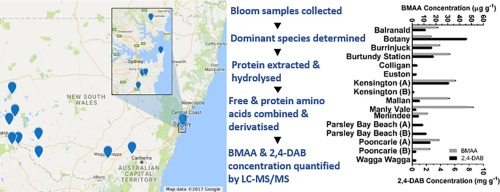Harmful Algae ( IF 5.5 ) Pub Date : 2018-03-27 , DOI: 10.1016/j.hal.2018.03.004 Brendan J. Main , Lee C. Bowling , Matthew P. Padula , David P. Bishop , Simon M. Mitrovic , Gilles J. Guillemin , Kenneth J. Rodgers

|
The emerging toxin β-methylamino-l-alanine (BMAA) has been linked to the development of a number of neurodegenerative diseases in humans including amyotrophic lateral sclerosis (ALS), Alzheimer’s disease, and Parkinson’s disease. BMAA has been found to be produced by a range of cyanobacteria, diatoms, and dinoflagellates worldwide, and is present in freshwater, saltwater, and terrestrial ecosystems. Surface scum samples were collected from waterways in rural and urban New South Wales, Australia and algal species identified. Reverse phase liquid chromatography-tandem mass spectrometry was used to analyse sixteen cyanobacterial scum for the presence of BMAA as well as its toxic structural isomer 2,4-diaminobutyric acid (2,4-DAB). BMAA was detected in ten of the samples analysed, and 2,4-DAB in all sixteen. The presence of these toxins in water used for agriculture raises concerns for public health and food security in Australia.
中文翻译:

在澳大利亚东部多个水域的蓝藻水华中检测到可疑的神经毒素β-甲基氨基-1-丙氨酸(BMAA)
新兴的毒素β甲氨基升-丙氨酸(BMAA)与人类多种神经退行性疾病的发展有关,包括肌萎缩性侧索硬化症(ALS),阿尔茨海默氏病和帕金森氏病。已发现BMAA由世界各地的各种蓝细菌,硅藻和鞭毛藻产生,并存在于淡水,盐水和陆地生态系统中。从澳大利亚新南威尔士州农村和城市的水道收集了表面浮渣样品,并鉴定了藻类。反相液相色谱-串联质谱法用于分析十六种蓝藻浮渣中是否存在BMAA及其毒性结构异构体2,4-二氨基丁酸(2,4-DAB)。在分析的十个样品中检测到BMAA,在全部十六个样品中检测到2,4-DAB。









































 京公网安备 11010802027423号
京公网安备 11010802027423号